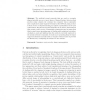Free Online Productivity Tools
i2Speak
i2Symbol
i2OCR
iTex2Img
iWeb2Print
iWeb2Shot
i2Type
iPdf2Split
iPdf2Merge
i2Bopomofo
i2Arabic
i2Style
i2Image
i2PDF
iLatex2Rtf
Sci2ools
ICANN
2011
Springer
2011
Springer
Transforming Auto-Encoders
The artificial neural networks that are used to recognize shapes typically use one or more layers of learned feature detectors that produce scalar outputs. By contrast, the computer vision community uses complicated, hand-engineered features, like SIFT [6], that produce a whole vector of outputs including an explicit representation of the pose of the feature. We show how neural networks can be used to learn features that output a whole vector of instantiation parameters and we argue that this is a much more promising way of dealing with variations in position, orientation, scale and lighting than the methods currently employed in the neural networks community. It is also more promising than the handengineered features currently used in computer vision because it provides an efficient way of adapting the features to the domain.
Computer Vision Community | Explicit Representation | Feature Detectors | ICANN 2011 | Neural Networks |
| Added | 29 Aug 2011 |
| Updated | 29 Aug 2011 |
| Type | Journal |
| Year | 2011 |
| Where | ICANN |
| Authors | Geoffrey E. Hinton, Alex Krizhevsky, Sida D. Wang |
Comments (0)

